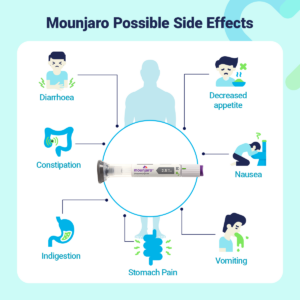If you’ve been considering asking your prescriber for a GLP-1 receptor agonist like Saxenda or Wegovy to help with weight loss you’ll probably have a lot of questions about what treatment looks like.
One of those questions may be about potential side effects and whether taking a different treatment could be better for you.
It’s always a good idea to be aware of the potential side effects of any medication you’re taking, and we’re happy to help you get to the answers you need no matter what stage of your treatment you’re at.
Let’s take a look at the side effects of different GLP-1 receptor agonists and whether one treatment would be better for you than another.
Why do Saxenda and Wegovy have similar symptoms?
Saxenda and Wegovy are members of a group of medications called GLP-1 receptor agonists, alongside Rybelsus, Ozempic, Victoza, Mounjaro, and many more. GLP-1 RAs are grouped together because they work in a very similar way to one another.
Another common example of this type of grouping is antihistamines, a group of allergy medications you may be familiar with if you have hay fever.
As they affect your body in similar ways GLP-1s like Liraglutide and Semaglutide (the active ingredients in Saxenda and Wegovy respectively) naturally have very similar side effects.
What are the most common side effects of GLP-1 receptor agonists?
The most common side effects patients usually experience while taking GLP-1 receptor agonists relate to your digestive system.
This includes symptoms like feeling or being sick, diarrhoea and constipation, in some cases it can mean gas, indigestion and heartburn too.
Most patients find that these symptoms happen at the beginning of their treatment when their body is getting used to the medication and gradually decrease as treatment continues.
Here is a list of some of the most common side effects we see affecting patients taking GLP-1 receptor agonists:
- Stomach ache or pain
- Feeling sick (nausea)
- Being sick (vomiting)
- Indigestion
- Heartburn or acid reflux
- Diarrhoea
- Constipation
- Headaches
- Feeling weak or tired
Do all GLP-1 agonists affect your digestive system?
Yes, all GLP-1 receptor agonists have side effects that affect your digestive system, which is down to how they work.
These medications interact with hormones that control your hunger and blood sugar levels, so it’s only natural that you may experience side effects related to that.
Anyone who experiences indigestion can tell you that sometimes the slightest change in your diet can cause stomach upsets, and taking a medication that works on your digestive system can have a similar result.
However, most patients find that their digestive symptoms gradually ease off as treatment continues, so unless your symptoms are unusual, you would likely be encouraged to continue treatment for a few weeks before making any potential changes to your plan.
If I have side effects with one treatment will I get them with all the others?
There’s never a guarantee of how medication could affect you when you start taking it, and that goes for GLP-1 receptor agonists as much as any other treatment.
Some people find that they experience side effects with one GLP-1 RA but don’t with another, whereas others find that they experience similar side effects no matter which treatment they’re taking.
Of course, it’s impossible for anyone to be sure which side effects you would have if you were prescribed a GLP-1 for diabetes or weight loss.
The best thing you could do is familiarise yourself with the list of potential side effects of the treatment you’ll be taking, warning signs for severe side effects, and what you should do if you experience them.
You can find more information in the patient information leaflet included with your treatment or you could ask your prescriber to explain the warning signs you should look out for.
Getting your treatment right is important, and your prescriber is there to help you get it right.
This may mean switching to another GLP-1 receptor agonist if one of them isn’t right for you, or ending your treatment entirely.
No matter which course of action you take, your safety should always come first.
How to reduce unwanted symptoms during treatment
There are a few things you can do to relieve unwanted side effects when you start treatment with GLP-1 RAs.
The first is built into the average treatment plan and it’s known as titration.
The name may sound complex but it’s the simple process of increasing your dosage of whichever treatment you take over time.
There are lots of different medications that follow this kind of plan, including GLP-1 receptor agonists, and one of the reasons it happens is due to side effects.
Slowly increasing your medication helps to prevent side effects as it gives your body a chance to get used to what’s happening gradually.
It also gives your healthcare team the opportunity to check how your treatment is going and assess whether it’s going to be right for you in the long term.
This is also important if you’re taking a GLP-1 for weight loss, as they can monitor your weight loss and ensure you’re hitting the targets you should be hitting if your treatment is successful.
As part of the service we provide here at myBMI, our prescribers may also provide supplementary treatments to help you until your unwanted symptoms settle down.
For example, if you’re suffering from heartburn and indigestion they may provide an antacid to help ease your symptoms until they subside.
In conclusion
We hope we’ve helped you get to grips with the side effects you may experience when you’re taking a GLP-1 agonist.
Remember, if in doubt, always talk to a medical professional and let them help — it’s what they’re there for, after all!
In the meantime, if you’d like to learn more about these medications and other weight management treatments why not take a look at some of our latest articles?
Here are some of our favourites that should help you learn what you need to know about your treatment options.


















